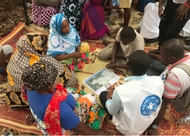Participatory mapping for community health in Mayotte

Residents contribute to mapping their neighborhoods

Médecins du Monde France has decided to call on CartONG in June 2022 to support it in carrying out participatory mapping workshops in Mayotte in two spontaneous neighborhoods on the island, Longoni and Dzoumogné, with the aim of improving its knowledge of the neighborhood in particular on the water points used and their accessibility, its operational deployment, while creating a community mobilization with the residents.
During a 2-week mission in the field, CartONG helped MdM design and implement a tailored participatory methodology, based on simple mapping tools that enable residents to actively contribute to the production of geographic information, while creating a framework for expression, exchange and listening between residents and the NGO.
Various workshops were organized both with MdM volunteers and with local residents. A number of playful exercises introduced residents to mapping, and together they defined the legend of the map they wanted for their neighborhood. A selection of tailored and accessible geographic data collection tools then enabled the residents, supported by MdM and its volunteers and trained by our team, to map their neighborhood for a day.
Residents collected a wealth of data on a wide range of topics. The challenge for CartONG was then to transform this data into maps. 6 maps were produced for each of the neighborhoods: 1 reference map and 5 thematic maps focusing on issues linked to access to drinking water, waste management, access to emergency services and spaces to be enhanced and protected.
Our support wrapped up with a feedback workshop with the participants, so that they could begin to apprehend the maps to better understand their neighborhood’s development issues and assert their rights to better living conditions.
Mapping the informal: impacts and implications

For this type of project, we usually recommend OpenStreetMap (OSM), the Wikipedia of maps. OSM not only makes data public – open data – but also, and above all, promotes its reuse and updating, guaranteeing the sustainability of mapping work.
As part of this project, MdM teams and local residents were concerned about the openness of the geographical data outputs produced during the workshops. Indeed, in a context where the fight against informal housing is extremely tense, concerns have been raised about the possibility of participating in the production of material that would justify destruction by the prefectural authorities or encourage police arrests.
When managing solidarity projects, it is essential for us to take into account the fragile relationship between the importance of producing knowledge and its potential negative repercussions. For our project in Mayotte, we chose not to transfer the cartographic data we produced to OSM, not only to protect the local population, but also to ensure their ownership of the project.
CartONG endeavors to question the risk/benefit ratio of mapping and open data, undoubtedly the most sensitive aspect. To this end, it is essential to discuss the project with the partner in order to understand the operational context! Finally, informing and including local residents in the mapping project is a key step. Acting as the main producers of data, their consent is essential to the launch and sustainability of the project.
One year on, where do things stand?
It’s now been a year since our support for the MdM teams came to an end. Where does the project stand today? Have the maps, and the participatory process that led to their creation, had an impact on MdM’s future work in these two neighborhoods? Have the local residents adopted this new tool?
MdM tells us that, based on each of these maps, residents came up with micro-projects to improve their living conditions. A vote was then held to select one of these projects, and a “Copil” – a steering committee – of residents and neighborhood associations was formed to implement it. In Longoni, where the theme of “access to water” was chosen, the project resulted in a truck carrying drinking water between the “Monetic Fountain Terminals” (Bornes Fontaines Monétiques) and the neighborhoods located in the hills. Four deliveries a week supply water to 123 households. The Red Cross, Solidarités International and the ARS are currently working together to ensure that access to water is sustained. In Dzoumogné, where the theme of “living together” was chosen, the project has resulted in the reinvestment of a previously unused Faré built by Caritas. Literacy classes for adults are held three times a week. The Ligue de l’Enseignement is involved in the project, offering cultural activities in French. Nine months later, the Copil meetings have resulted in the concrete realization of the citizen initiatives that emerged from the participatory mapping.
Convinced of the added value of participatory mapping for any action in a “new” neighborhood, whatever the project theme, MdM has decided to share its experience at the Société Française de Santé Publique conference this fall. The NGO will present how participatory mapping workshops are both an essential operational tool, and a necessary and useful way of reaching out to residents and creating opportunities for them to express themselves.
Our approach is to reach out to the residents to understand their problems, […] we were convinced that a project of this type could motivate the residents, mobilize them to improve their living conditions – it was also an opportunity to get to know each other better and create links with the residents. – Project Manager for Médecins du Monde France in Mayotte
